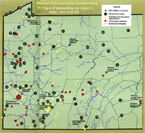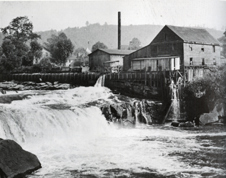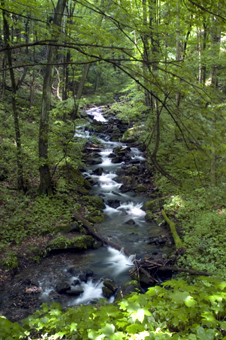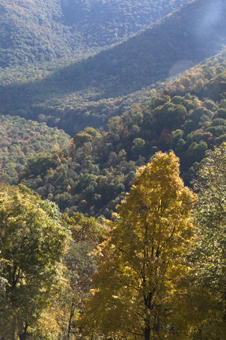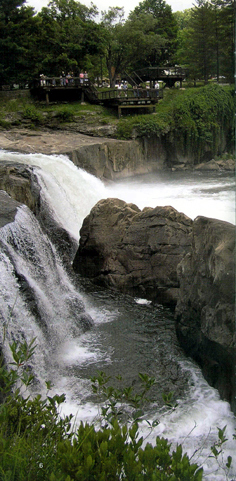|
Conserve |
|
| Conserve 75th Anniversary Commemorative Issue |
| 1930s - 40s |
| 1950s |
| 1960s |
| 1970s |
| 1980s |
| 1990s |
| 2000s |
| Fall 2007 Home |
| Past Issues |
1950s
Appreciating Ohiopyle “Ohiopyle.” Just hearing the name evokes mystery, introduces allure. Before the first visit the mind forms an impression of a place that cannot be among the ordinary locales in which we spend our days. The place must, hopes the heart, be unique, untouched somehow by time and change. And so it is. Ohiopyle conceals but offers much within its mist-shrouded gorge and across its forested slopes. At 20,000 acres it is extensive enough, with the right mix of rock ledge, rapid, boulder, big tree and river beach to harbor a nearly full range of these mountains’ native living things. It is a green climate-carved reservoir of the fundamental identity of this part of the Earth. That is reason enough to respect, protect and restore this place where the Youghiogheny cleaves the Laurel Ridge, then probes away toward the west. We need Ohiopyle and places like it, though, for more than a representation of what wild still remains. We need it for ourselves, as an avenue to connect to the un-made world. At Ohiopyle we can shed techno-obsession and participate in natural place and process...catch a trout; power a boat with wrist, arm and back; wonder at a warbler’s gold-green flash and sleep in the woods. Such things are beyond price, beyond value. They are a touchstone to the timeless in a day of rapid change. They are a hint of our human origins. They confirm our affinity for things that aren’t for sale. They restore our frayed connection to seasons, climate, landscapes and all other life. Ohiopyle is for connecting, and for that, more than anything, it merits our care. Ben Moyer is an award-winning author and essayist whose writing on nature and conservation issues has appeared in numerous state, regional and national publications. He is also an outdoors columnist for the Pittsburgh Post-Gazette.
Eli's Glen in Ohiopyle (Photo by Paul g. Wiegman)
The Youghiogheny River Gorge in Ohiopyle State Park (Photo by Paul g. Wiegman)
|
The Three Voices that Saved Ohiopyle Ohiopyle State Park exists in its present form because of three individuals: Lillian McCahan, Edgar Kaufmann Sr. and Mrs. Albert S. Keister. The earliest, and most persistent, was Lillian McCahan, a station agent for McCahan had discovered that a developer wished to purchase Ferncliff
Peninsula, cut the lumber and build an amusement park and contacted
Western Pennsylvania Conservancy President Charles Chubb. Dr. Chubb
formed a committee and it became quickly apparent that, given the time Dr. Chubb contacted Edgar Kaufmann and asked if his Charitable Trust would advance the $40,000 necessary for the Ferncliff property. The WPC board decided to offer below the asking price and turned in a bid of $37,500. There was no immediate reply and the board later discovered that the principal heir had died on a Uniontown golf course. The deal was accepted, which pleased Mr. Kaufmann “immensely” according to Dr. Graham Netting’s report. Not all in the Laurel Highlands shared his sentiment. “Lumbermen had anticipated more work when Ferncliff was timbered and shopkeepers looked forward to the surge in business that an amusement park would bring,” Netting wrote. “Instead of a heaven-sent developer, they had ended with a poor organization acting as custodian of a scenic treasure.” The Keister family, of Sewickley, Pa, owned some 589 acres that comprised
the wooded slopes facing Ferncliff Peninsula. The land had been subdivided
into unmanageable factions owned by far-flung members of the Keister family.
Mrs. Albert Fraiser Keister told the Conservancy she would work to convince
other members of the family to donate or sell the land. In 1960, she dedicated
herself for more than a year and used her own funds to buy the interests of
many holders and eneficiaries of the land. In 1961, she donated her half Today, at nearly 20,000 acres, Ohiopyle is Pennsylvania’s second largest state park, and one of the busiest, due to its popularity among rafting, camping and hiking enthusiasts. An old power house at Ohiopyle Falls in 1912. It was at this time that a local
|
1951 The Greater Pittsburgh Parks Association recognizes the need to expand the scope of its efforts and becomes The Western Pennsylvania Conservancy.
Ferncliff Peninsula at Ohiopyle in Fayette County acquired through gift from Edgar J. Kaufmann Charitable Trust.
1952 (1962, 1969) 310-acre natural area acquired in Butler County for Jennings Nature Reserve (now known as Jennings Environmental Education Center and owned by Bureau of State Parks). Named for the famous botanist, Dr. Otto Emery Jennings, the reserve includes prairie-like species, such as the wildflower
blazing star and the endangered eastern massasauga rattlesnake.
1955 Heiner Memorial acquired, a wildflower-covered slope along Bear Creek in
Butler County.
1957 Charles F. Lewis is named the WPC’s president. He would serve for the next 12 years, accepting no compensation for the first few years. Dr. Lewis had been president of the Buhl Foundation before becoming president of the Western Pennsylvania Conservancy
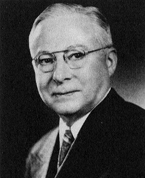
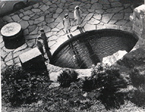
A fountain commemorating WPC President Charles Chubb at McConnell's Mill State Park.

